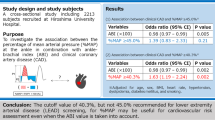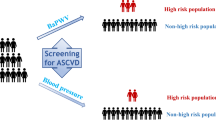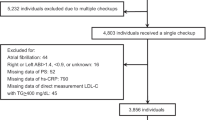Abstract
Ankle–brachial index (ABI) measurement offers an easily available method to diagnose peripheral artery disease (PAD) and systemic atherosclerosis in early stage and thus to identify high-risk individuals for preventive interventions. The objective of this study was to assess the most practical criteria for the measurement of ABI in subjects with high cardiovascular risk. We examined 972 asymptomatic, middle-aged high-risk subjects without manifested cardiovascular disease or previously diagnosed diabetes. The prevalence of PAD (defined as ABI⩽0.90) and borderline PAD (0.91–1.00) were 5% (95% confidence interval (CI) 4–7%) (49/972) and 20% (95% CI 18–23%) (192/972), respectively. In multivariate analysis, female gender (odds ratio (OR) 0.71 (95% CI 0.53–0.97)), current smoking (OR 2.14 (95% CI 1.47–3.11)) and pulse pressure (OR 1.03 for each increase of 1 mm Hg (95% CI 1.01–1.04)) were associated with low ABI. Measuring ABI in subjects who smoke or have pulse pressure >65 mm Hg seems to be worthwhile.
This is a preview of subscription content, access via your institution
Access options
Subscribe to this journal
Receive 12 digital issues and online access to articles
$119.00 per year
only $9.92 per issue
Buy this article
- Purchase on Springer Link
- Instant access to full article PDF
Prices may be subject to local taxes which are calculated during checkout


Similar content being viewed by others
References
Fowkes FGR, Low LP, Tuta S, Kozak J . Ankle-brachial index and extent of atherothrombosis in 8891 patients with or at risk of vascular disease: results of the international AGATHA study. Eur Heart J 2006; 27: 1861–1867.
Diehm C, Schuster A, Allenberg JR, Darius H, Haberl R, Lange S et al. High prevalence of peripheral artery disease and co-morbidity in 6880 primary care patients: cross sectional study. Atherosclerosis 2004; 172: 95–105.
Zheng ZJ, Sharrett AR, Chambless LE, Rosamond WD, Nieto FJ, Sheps DS et al. Associations of ankle-brachial index with clinical coronary heart disease, stroke and preclinical carotid and popliteal atherosclerosis: the atherosclerosis risk in communities (ARIC) study. Atherosclerosis 1997; 131: 115–125.
Weatherley BD, Nelson JJ, Heiss G, Chambless LE, Sharrett AR, Nieto FJ et al. The association of the ankle-brachial index with incident coronary heart disease: the Atherosclerosis Risk In Communities (ARIC) study, 1987-2001. BMC Cardiovasc Disord 2007; 7: 3.
Lamina C, Meisinger C, Heid IM, Löwel H, Rantner B, Koenig W et al. Association of ankle-brachial index and plaques in the carotid and femoral arteries with cardiovascular events and total mortality in a population-based study with 13 years of follow-up. Eur Heart J 2006; 27: 2580–2587.
Fowkes FGR, Murray GD, Butcher I, Heald CL, Lee RJ, Chambless LE et al. Ankle brachial index combined with Framingham risk score to predict cardiovascular events and mortality. A meta-analysis. JAMA 2008; 300: 197–208.
Stoffers HE, Rinkens PE, Kester AD, Kaiser V, Knottnerus JA . The prevalence of asymptomatic and unrecognized peripheral artery occlusive disease. Int J Epidemiol 1996; 25: 282–290.
Murabito JM, Evans JC, Nieto K, Larson MG, Levy D, Wilson PWF . Prevalence and clinical correlates of peripheral artery disease in the Framingham Offspring Study. Am Heart J 2002; 143: 961–965.
McGrae McDermott M, Liu K, Criqui MH, Ruth K, Goff D, Saad MF et al. Ankle brachial index and subclinical cardiac and carotid disease. The Multi-Ethnic Study of Atherosclerosis. Am J Epidemiol 2005; 162: 33–41.
Pande RL, Perlstein TS, Beckman JA, Creager MA . Association of insulin resistance and inflammation with peripheral artery disease. The National Health and Nutrition Examination Survey, 1999 to 2004. Circulation 2008; 118: 33–41.
Menke A, Muntner P, Wildman RP, Dreisbach AW, Raggi P . Relation of borderline peripheral artery disease to cardiovascular disease risk. Am J Cardiol 2006; 98: 1226–1230.
Tendera M, Aboyans V, Bartelink M-L, Baumgartner I, Clément D, Collet J-P et al. ESC guidelines on the diagnosis and treatment of peripheral artery disease. Eur Heart J 2011; 32: 2851–2906.
Alberti KG, Zimmet P, Shaw J and IDF Epidemiology Task Force Consensus Group. The metabolic syndrome—a new worldwide definition. Lancet 2005; 366: 1059–1062.
Conroy RM, Pyörälä K, Fitzgerald AP, Sans S, Menotti A, De Backer G et al on behalf of the SCORE project group. Estimation of ten-year risk of fatal cardiovascular disease in Europe: the SCORE project. Eur Heart J 2003; 24: 987–1003.
Grundy SM, Cleeman JI, Daniels SR, Donato KA, Eckel RH, Franklin BA et al. Diagnosis and management of the metabolic syndrome. An American Heart Association/National Heart, Lung, and Blood Institute Scientific Statement. Executive summary. Circulation 2005; 112: e285–e290.
Espinola-Klein C, Rupprecht HJ, Bickel C, Lackner K, Savvidis S, Messow CM et al. Different calculations of ankle-brachial index and their impact on cardiovascular risk prediction. Circulation 2008; 118: 961–967.
Diehm C, Allenberg JR, Pittrow D, Mahn M, Tepohl G, Haberl RL et al. Mortality and vascular morbidity in older adults with asymptomatic versus symptomatic peripheral artery disease. Circulation 2009; 120: 2053–2061.
Lahoz C, Vicente I, Laguna F, Garcìa-Iglesias MF, Taboada M, Mostaza JM . Metabolic syndrome and asymptomatic peripheral artery disease in subjects over 60 years of age. Diabetes Care 2006; 1: 148–150.
Franklin SS, Khan SA, Wong ND, Larson MG, Levy D . Is pulse pressure useful in predicting risk for coronary heart disease? The Framingham Heart Study. Circulation 1999; 100: 354–360.
Glynn RJ, Chae CU, Guralnik JM, Taylor JO, Hennekens CH . Pulse pressure and mortality in older people. Arch Intern Med 2000; 160: 2765–2772.
Chae CU, Pfeffer MA, Glynn RJ, Mitchell GF, Taylor JO, Hennekens CH . Increased pulse pressure and risk of heart failure in the elderly. JAMA 1999; 281: 634–639.
Vaccarino V, Berger AK, Abramson J, Black HR, Setaro JF, Davey JA et al. Pulse pressure and risk of cardiovascular events in the systolic hypertension in the elderly program. Am J Cardiol 2001; 88: 980–986.
Nielsen WB, Lindenstrom E, Vestbo J, Jensen GB . Is diastolic hypertension an independent risk factor for stroke in the presence of normal systolic blood pressure in the middle-aged and elderly? Am J Hypertens 1997; 10: 634–639.
Domanski MJ, Davis BR, Pfeffer MA, Kastantin M, Mitchell GF . Isolated systolic hypertension. Prognostic information provided by pulse pressure. Hypertension 1999; 34: 375–380.
Gasowski J, Fagard RH, Staessen JA, Grodzicki T, Pocock S, Boutitie F et al. Pulsatile blood pressure component as predictor of mortality in hypertension: a meta-analysis of clinical trial control groups. J Hypertens 2002; 20: 145–151.
Stramba-Badiale M, Fox KM, Priori SG, Collins P, Daly C, Graham I et al. Cardiovascular diseases in women: a statement from the policy conference of the European Society of Cardiology. Eur Heart J 2006; 27: 994–1005.
Fowkes FG, Housley E, Riemersma RA, Macintyre CC, Cawood EH, Prescott RJ et al. Smoking, lipids, glucose intolerance, and blood pressure as risk factors for peripheral atherosclerosis compared with ischemic heart disease in the Edinburgh Artery Study. Am J Epidemiol 1992; 135: 331–340.
Criqui MH . Peripheral artery disease—epidemiological aspects. Vasc Med 2001; 6: 3–7.
Rooke TW, Hirsch AT, Misra S, Sidawy AN, Beckman JA, Findeiss LK et al2011 ACCF/AHA focused update of the guideline for the management of patients with peripheral artery disease. J Am Coll Cardiol 2011; 58: 2020–2045.
Acknowledgements
This work was supported by the Central Satakunta Health Federation of Municipalities.
Author information
Authors and Affiliations
Corresponding author
Ethics declarations
Competing interests
The authors declare no conflict of interest.
Rights and permissions
About this article
Cite this article
Korhonen, P., Kautiainen, H. & Aarnio, P. Pulse pressure and subclinical peripheral artery disease. J Hum Hypertens 28, 242–245 (2014). https://doi.org/10.1038/jhh.2013.99
Received:
Revised:
Accepted:
Published:
Issue Date:
DOI: https://doi.org/10.1038/jhh.2013.99
Keywords
This article is cited by
-
The Relationship Between High Pulse Pressure and Low Ankle-Brachial Index. Potential Utility in Screening for Peripheral Artery Disease in Population-Based Studies
High Blood Pressure & Cardiovascular Prevention (2015)
-
Ankle-brachial blood pressure index predicts cardiovascular events and mortality in Japanese patients with chronic kidney disease not on dialysis
Hypertension Research (2014)



